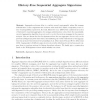EUROCRYPT
2012
Springer
12 years 10 months ago
2012
Springer
We provide an alternative method for constructing lattice-based digital signatures which does not use the “hash-and-sign” methodology of Gentry, Peikert, and Vaikuntanathan (ST...
PKC
2012
Springer
12 years 10 months ago
2012
Springer
We revisit the definition of unforgeability of blind signatures as proposed by Pointcheval and Stern (Journal of Cryptology 2000). Surprisingly, we show that this established de�...
INFOCOM
2012
IEEE
12 years 10 months ago
2012
IEEE
Abstract— Wireless link signature is a physical layer authentication mechanism, which uses the unique wireless channel characteristics between a transmitter and a receiver to pro...
IACR
2011
13 years 7 months ago
2011
A transitive signature scheme allows to sign a graph in such a way that, given the signatures of edges (a, b) and (b, c), it is possible to compute the signature for the edge (or ...
IACR
2011
13 years 7 months ago
2011
Abstract. We show that the Winternitz one-time signature scheme is existentially unforgeable under adaptive chosen message attacks when instantiated with a family of pseudo random ...
IACR
2011
13 years 7 months ago
2011
Aggregation schemes allow to combine several cryptographic values like message authentication codes or signatures into a shorter value such that, despite compression, some notion o...
IACR
2011
13 years 7 months ago
2011
In this paper we present a new practical key-recovery attack on the SFLASH signature scheme. SFLASH is a derivative of the older C∗ encryption and signature scheme that was broke...
IACR
2011
13 years 7 months ago
2011
We present the hash-based signature scheme XMSS. It is the first provably (forward) secure and practical signature scheme with minimal security requirements: a pseudorandom and a ...
IACR
2011
13 years 7 months ago
2011
We present a generic transformation that allows us to use a large class of pairing-based signatures to construct schemes for signing group elements in a structure preserving way. A...
100
click to vote
ASIACRYPT
2011
Springer
13 years 7 months ago
2011
Springer
We provide constructions of (m, 1)-programmable hash functions (PHFs) for m ≥ 2. Mimicking certain programmability properties of random oracles, PHFs can, e.g., be plugged into ...


